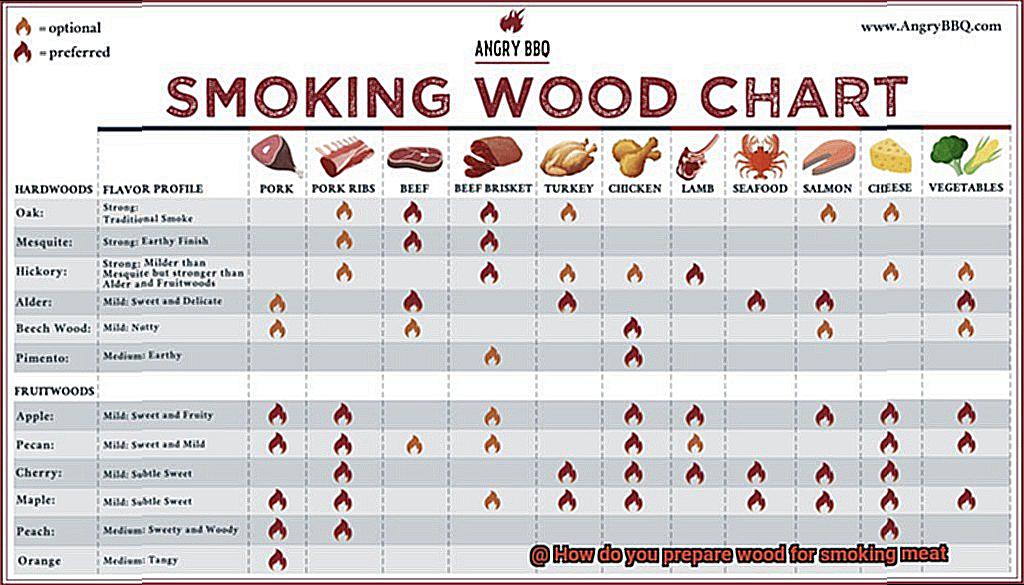Are you ready to take your meat smoking game to the next level? It’s not just about having the right equipment and quality meat – it’s also about using the right type of wood to add an extra layer of flavor and aroma to your smoked meat. But do you know how to prepare wood for smoking meat like a pro?
Preparing wood for smoking is more than just grabbing any old piece of wood and tossing it into the smoker. Different woods impart unique flavors and aromas to the meat, making it essential to choose the right one for your dish. For example, mesquite wood is perfect for beef and pork, while applewood is ideal for poultry and fish.
But before you use wood for smoking, it’s crucial to know how to prepare it correctly. Soaking, curing, and seasoning are some of the most common techniques that help enhance the wood’s flavor while ensuring even burning without producing too much smoke.
In this blog post, we’ll take a closer look at each of these techniques and explore how you can use them to enhance your smoked meat’s flavor and aroma. Whether you’re a seasoned pro or beginner, we’ve got you covered with everything you need to know about preparing wood for smoking meat. So let’s dive in.
Contents
Choosing the Right Type of Wood
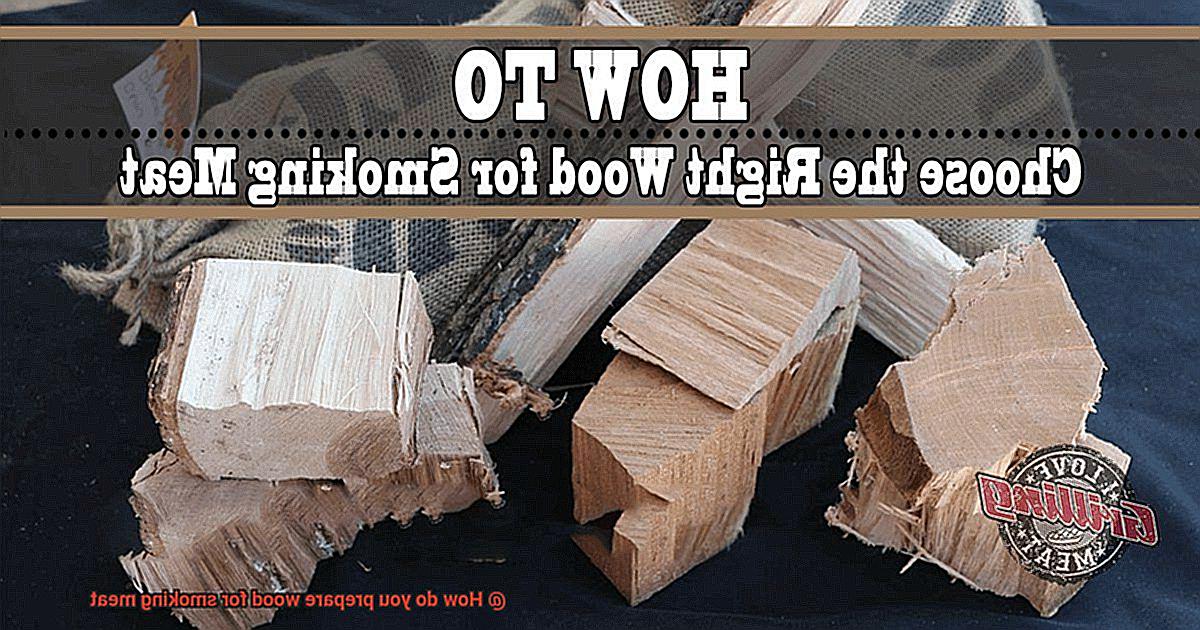
Smoking meat is not just about cooking but also about creating a masterpiece of flavor and aroma. The type of wood used in smoking is a crucial factor in achieving the desired result. The perfect wood for smoking meat should complement, not overpower, the meat’s flavor.
When choosing the right type of wood for smoking meat, several factors need to be considered. One of them is the intensity of the smoke flavor. Mesquite and hickory are strong and bold in flavor, but they can quickly overpower the meat if used excessively. Fruitwoods like apple, cherry, or peach have a milder smoke flavor that complements the meat without overpowering it.
Another factor to consider is the type of meat being smoked. Beef and pork are typically smoked with stronger woods like hickory or mesquite, while poultry and fish are better suited for milder woods like apple or alder.
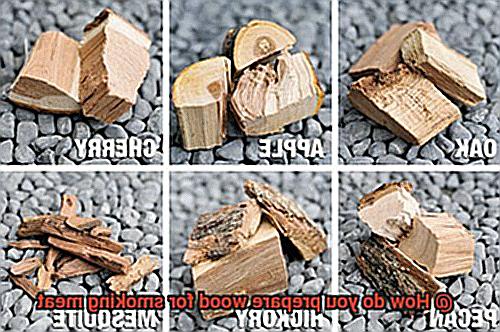
It’s important to note that only hardwoods should be used for smoking because softwoods like pine and cedar contain toxins that can be harmful when ingested. Additionally, seasoning the wood by letting it sit outside for a few months to dry out and get rid of any sap or moisture is essential. Freshly cut wood contains too much moisture, which can cause bitter smoke and negatively affect the flavor of the meat. Seasoned wood burns cleaner and produces a better flavor.
Checking the moisture content of the wood before using it is also crucial. Wood that is too dry can burn too quickly and produce too much heat, while wood that is too wet can produce bitter smoke and ruin the taste of the meat. The ideal moisture content for smoking wood should be around 20%.
The size of the wood also plays a significant role in smoking meat. Wood that is too large can take a long time to burn and may produce too much smoke, while wood that is too small may burn too quickly and not produce enough smoke. The ideal size for smoking wood should be around 2-3 inches in diameter and 6-8 inches in length.
Seasoning the Wood
There’s something magical about the scent of perfectly smoked meat. But did you know that the secret to achieving that delicious flavor lies in the wood? That’s right, seasoning the wood is a crucial step in preparing it for smoking meat. As an expert in this area, let me guide you through the process.
First, it’s important to choose the right type of wood. Each type has a unique flavor profile that can complement or overpower the taste of your meat. Popular choices include hickory and mesquite for bold flavors like beef and pork, while applewood and cherry are perfect for lighter meats like chicken and fish.
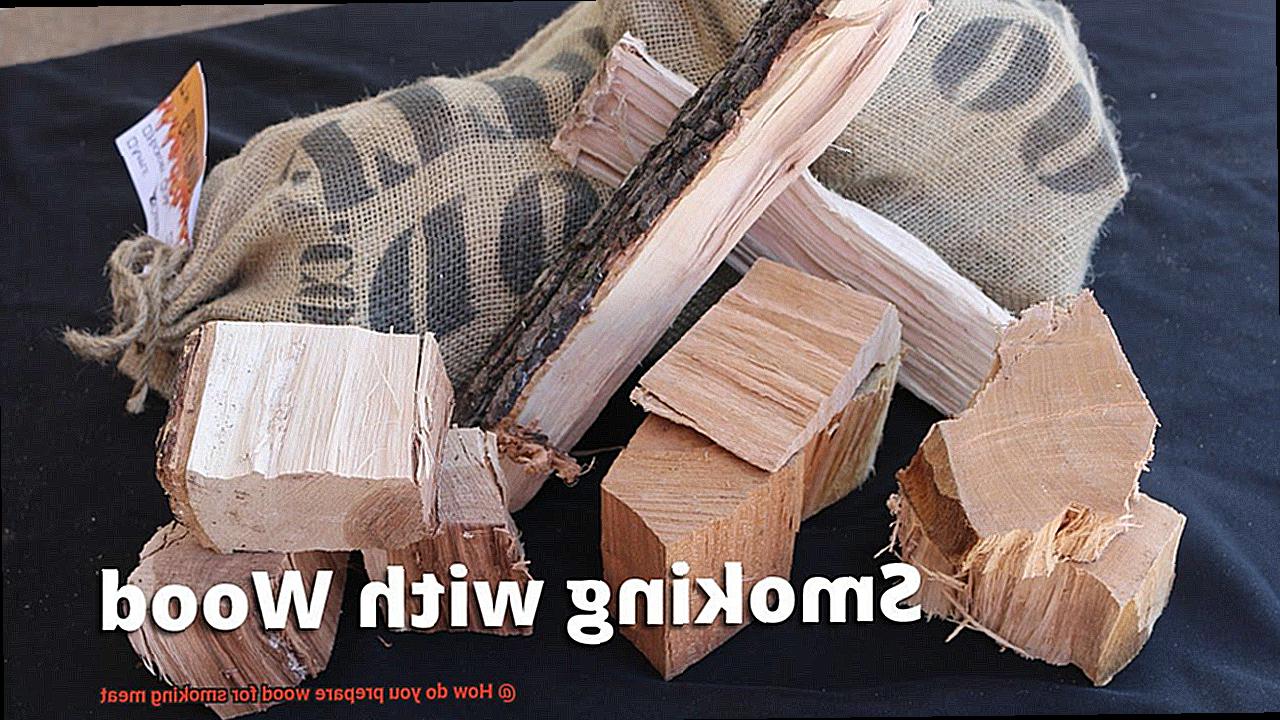
Once you’ve selected your wood, it’s time to move onto the seasoning process. This involves drying out the wood to remove any excess moisture that could produce a bitter taste in the meat. It also reduces the amount of creosote produced during smoking, which can cause a bitter taste and leave residue on the meat.
To season your wood, cut it into small pieces and store it in a dry, well-ventilated area. The length of time required for seasoning will depend on several factors such as the type of wood and humidity levels. Generally, it can take anywhere from several weeks to several months.
To test if your wood is properly seasoned, perform a simple snap test. Take a piece of wood and try to break it in half. If it snaps easily and cleanly, then it’s ready for use. If it bends or flexes without breaking, then it needs more time to dry out.
Remember that seasoning the wood isn’t just about removing excess moisture – it also ensures a cleaner smoke that enhances the flavor of your meat. So take the time to properly season your wood – your taste buds (and guests) will thank you.
Checking the Moisture Content
As you prepare your wood for smoking meat, there’s one crucial factor you must consider: moisture content. Achieving the ideal moisture content of 20% is essential for producing a clean burn and a consistent smoke that will infuse your meat with delicious flavor. But how can you ensure your wood is at the optimal moisture level?
There are several methods you can use to check the moisture content of your smoking wood. The first and most accurate method is to use a moisture meter, which can be purchased at most hardware or home improvement stores. Simply insert the prongs of the meter into the wood and wait for the reading to display. With this method, you’ll be able to confirm whether your wood has reached the ideal moisture level of 20%.
If you don’t have access to a moisture meter, there are other ways to check your smoking wood’s moisture content. One option is to examine the end grain of a split piece of wood. If it appears dry and cracks easily, it’s too dry for smoking. Conversely, if it appears wet or has a spongy texture, it may be too wet for smoking.
Another way to check moisture content is by weighing your wood before and after drying it in an oven at 225°F (107°C) for several hours until it reaches a stable weight. By comparing the weight before and after drying, you’ll know how much moisture was in the wood before it was dried. Aim for a weight loss of around 10-15% to achieve optimal moisture content.
Sizing the Wood
Sizing the wood is one of those crucial details that can make or break your smoked meat. So, let’s dive into the importance of properly sizing wood for smoking meat.
First, it’s important to understand the science behind it. The size of the wood determines the amount of smoke that will be produced. Larger pieces will have less surface area exposed to the heat, resulting in less smoke and flavor. Smaller pieces will burn faster and produce more smoke, giving your meat that rich and delicious taste that we all crave.
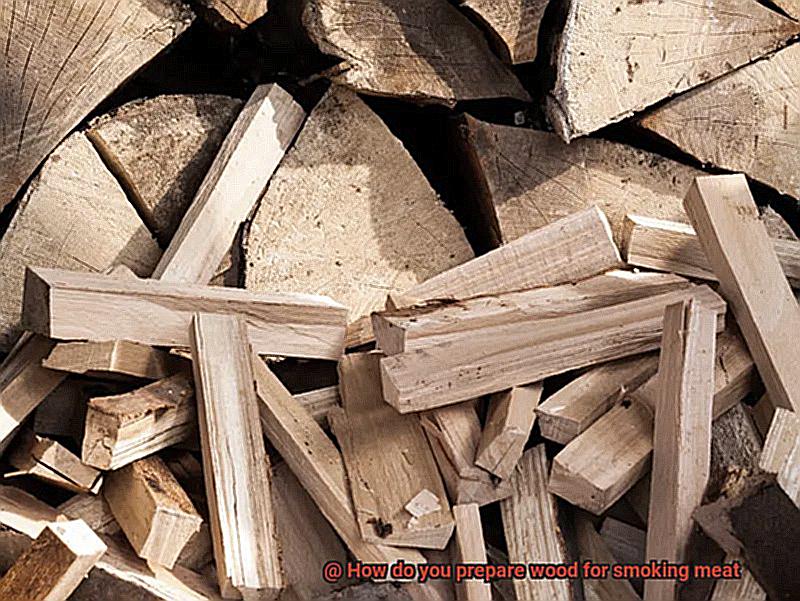
But that’s not all. Different types of wood produce different flavors of smoke. Mesquite wood has a strong and bold flavor, while apple and cherry woods produce a sweeter and milder flavor. When sizing your wood, consider not only the size but also the type of wood that will complement your meat’s natural flavors.
Before sizing your wood, it needs to be seasoned or dried out. Freshly cut wood contains too much moisture and will produce a bitter and unpleasant smoke. To prevent this, store your wood in a dry and well-ventilated area for several months before sizing it into small pieces about the size of a fist or smaller.
When it’s time to size your wood, safety should always be a top priority. Wear protective gear like gloves and eye protection when handling sharp tools like saws or axes. The goal is to create small pieces that will fit easily into your smoker without overcrowding.
To summarize, sizing the wood is a crucial step in preparing it for smoking meat. The right size and type of wood can make all the difference in achieving that perfect flavor. So take your time, pay attention to detail, and prepare your wood with care for a flavorful and enjoyable end product.
Remember:
Benefits of Preparing Wood for Smoking Meat
Then, you need to start preparing your wood for smoking meat. Not only does it enhance the flavor of your meat, but it also offers several benefits that make it a preferred method of cooking.
First off, let’s talk about the taste. Smoking meat infuses it with a subtle, smoky aroma that adds depth and complexity to its flavor profile. You can experiment with different types of wood to achieve unique flavor profiles that are sure to tantalize your taste buds. Hickory wood is ideal for a sweet and smoky flavor, while mesquite wood provides an intense and bold smokiness.
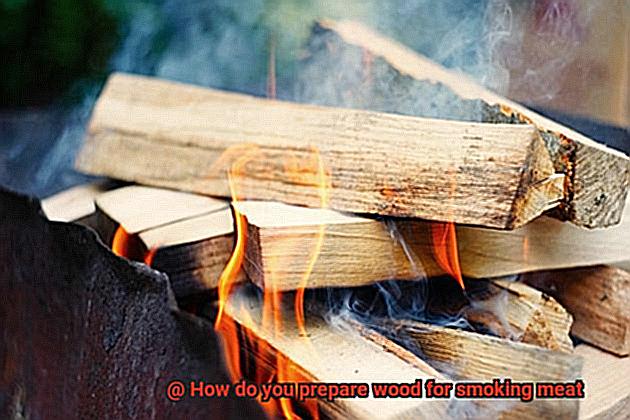
But smoking meat isn’t just about delicious flavor; it’s also a healthier option compared to other cooking methods like frying or grilling. By slow-cooking the meat, you retain its natural juices and nutrients, making it a healthier choice for those looking to eat better.
Another benefit of preparing wood for smoking meat is its cost-effectiveness. You don’t need expensive equipment to smoke meat; all you need are readily available wood chips or chunks. This makes it an ideal option for people looking to cook on a budget without sacrificing flavor.
Furthermore, smoking meat also helps preserve it by reducing its moisture content, making it less susceptible to bacterial growth and spoilage. This means that you can enjoy your delicious smoked meat for longer periods without worrying about it going bad.
Different Types of Woods and Their Flavors
Smoking meat is an art form that requires a deep understanding of the different types of wood used and their flavors. Each wood has a unique flavor profile that can significantly impact the taste of the final product. In this article, we will explore the different types of woods and their flavors used for smoking meat.
Mesquite
Mesquite is a popular wood used for smoking meat, especially in Texas-style barbecue. Its strong, earthy flavor pairs well with beef and game meats. However, mesquite burns hot and fast, so it’s essential to use it sparingly to prevent overpowering the meat.
Hickory
Hickory is another popular wood used for smoking meat. Its strong, smoky flavor pairs perfectly with pork, chicken, and beef. Hickory can be overwhelming if used in large quantities, so it’s best to use it sparingly, especially if you’re new to smoking.
Apple
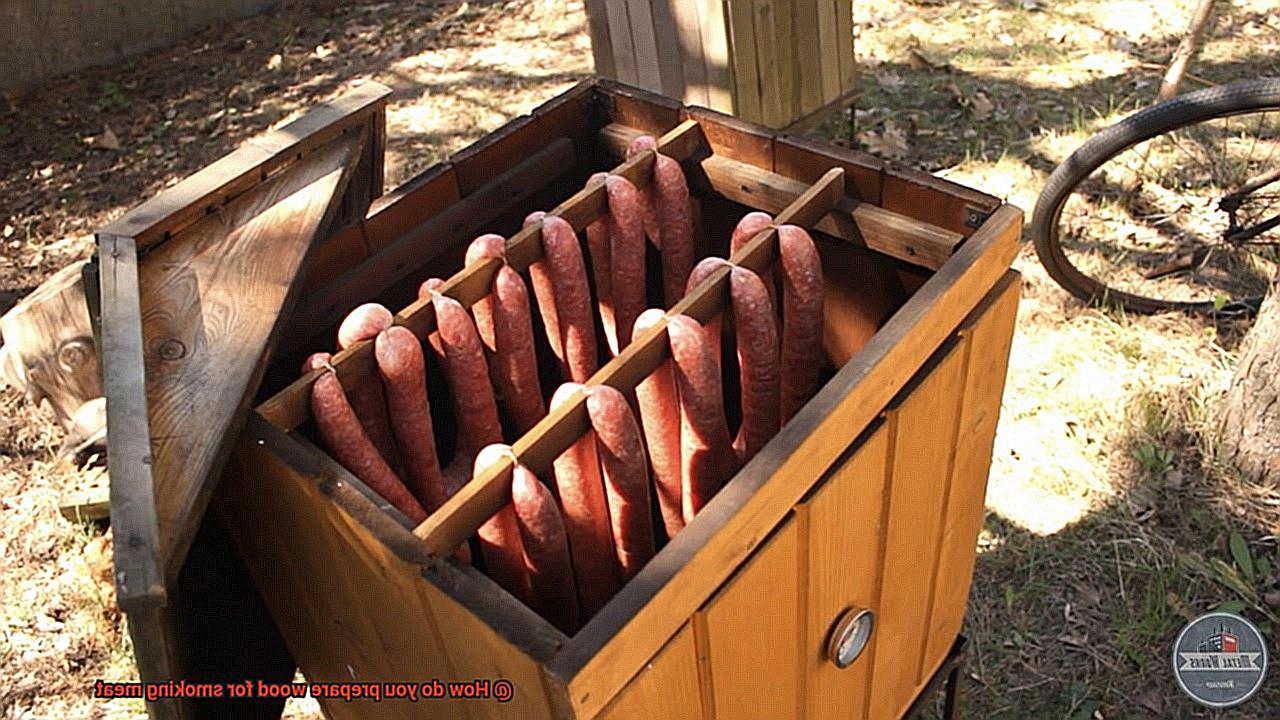
Applewood has a sweet, fruity flavor that works well with pork, chicken, and fish. It burns slowly and produces a mild smoke that won’t overpower the meat’s natural flavor. Applewood is also a great option for those who prefer milder smoke flavors.
Cherry
Cherrywood has a mild, sweet taste that pairs well with beef, pork, and poultry. It burns slowly and produces a subtle smoke that won’t overpower the meat’s natural flavors. Cherrywood is also known for giving meat a beautiful reddish hue.
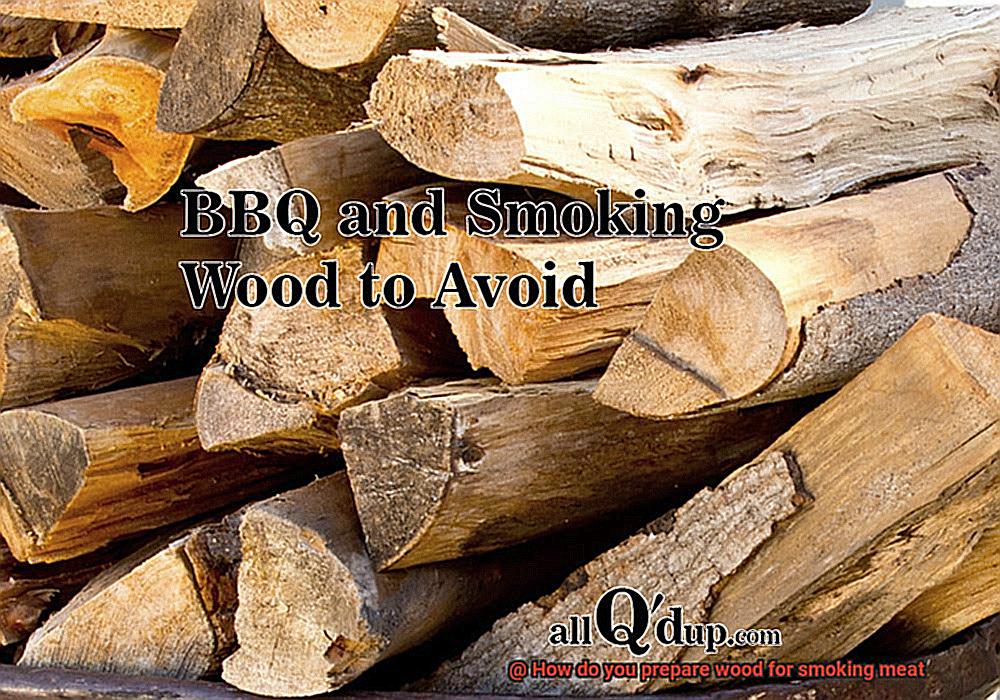
Oak
Oakwood is a versatile wood that has a mild flavor that works well with most meats. It burns hot and slow and produces a neutral smoke that won’t mask the meat’s natural flavors. Oakwood is also popular because it’s widely available and easy to find.
Pecan
Pecan wood has a sweet and nutty flavor that pairs well with pork and chicken. It burns slowly and produces a mild smoke that adds a subtle sweetness to the meat. Pecan wood is a great option for those who want to add a unique and distinct flavor to their meat.
Alder
Alderwood has a mild, slightly sweet flavor that works well with fish and poultry. It burns slowly and produces a delicate smoke that won’t overpower the meat’s natural flavors. Alderwood is also a popular choice for smoking salmon.
Tips and Tricks for Preparing Wood for Smoking Meat
Smoking meat is an art form that requires attention to detail and careful preparation. One of the most crucial steps in this process is preparing the wood for smoking. The type of wood you choose can greatly impact the flavor and aroma of your meat, so it’s important to select the right wood and prepare it properly. Here are some tips and tricks to help you achieve the perfect smoky flavor:
Choose the Right Wood
The first step in preparing wood for smoking is choosing the right type of wood. Different types of wood provide different flavors, so it’s important to choose one that complements the type of meat you’re smoking. For instance, oak and hickory provide a strong, bold flavor that works well with beef and pork, while fruitwoods like apple and cherry offer a milder, sweeter taste that pairs well with poultry and fish.
Soak the Wood
Soaking your wood before using it for smoking can help prevent it from burning too quickly and producing harsh smoke. This is especially important for smaller chips or chunks of wood, which can burn up quickly without proper soaking. However, not all woods need to be soaked, so make sure to research the type of wood you’re using before soaking.
Season Your Wood
Seasoning your wood involves heating it in a smoker or over a fire to remove excess moisture and infuse it with flavor. This process can take several hours but can greatly enhance the smoky flavor of your meat. Seasoning also helps to make your wood burn more evenly and consistently.
Store Wood Properly
Proper storage of wood is crucial to ensure that it stays dry and ready for use. Moisture can cause mold growth on the wood, which can affect the taste of your meat. To prevent this, store your wood in a cool, dry place away from any moisture or humidity.
Experiment with Different Woods
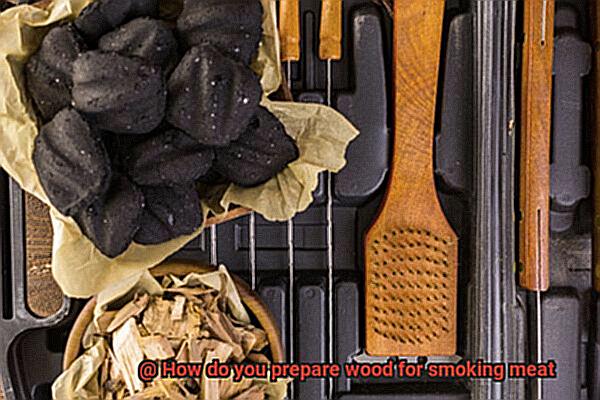
Don’t be afraid to experiment with different types of woods to see which ones work best for you. Keep a logbook of your experiments to help you remember which woods produced your favorite flavors. Mixing different woods together can also lead to unique flavor combinations that are sure to impress.
Common Mistakes to Avoid When Preparing Wood for Smoking Meat
Well, then you know that the type of wood used can make or break the flavor of the final product. However, many people make mistakes when preparing their wood for smoking, which can lead to less than desirable results. Here are some common mistakes to avoid when preparing wood for smoking meat:
First and foremost, not soaking the wood is a mistake that can ruin your smoked meat. Soaking the wood for at least 30 minutes before using it for smoking helps to prevent the wood from burning too quickly and creating an unpleasant flavor. The damp wood also produces more smoke, which enhances the taste of the meat.
Using too much wood is another mistake that many people make while smoking meat. Overdoing it can lead to an overpowering and bitter flavor, which is not what we’re looking for here. It’s best to use around 4-6 chunks or chips of wood per hour of smoking to get the perfect balance.
The type of wood used is also essential in determining the flavor of the meat. Using the wrong kind of wood can ruin all your efforts. Different woods will impart different flavors to the meat, so choose wisely. For example, mesquite is a strong wood and should be used sparingly, while cherry or apple wood is milder and can be used more liberally.
Not letting the wood burn down before adding it to the smoker is another common mistake that many beginners make while smoking meat. It’s important to let the wood burn down to embers before adding it to the smoker. This ensures that it smolders and produces smoke instead of flames, which can result in a harsh flavor.
yzP_LTeq100″ >
Conclusion
In conclusion, smoking meat is an art form that requires attention to detail and a keen understanding of the role that wood plays in creating mouth-watering flavors and aromas. When it comes to selecting the right type of wood, it’s crucial to consider factors like smoke intensity, meat type, seasoning, moisture content, and sizing.
Seasoning your wood is vital for removing excess moisture that could lead to a bitter taste in your meat. Checking the moisture content ensures optimal burning and infuses your meat with delicious flavor. Sizing your wood is also essential because it determines how much smoke will be produced. Each type of wood imparts a unique flavor; mesquite boasts bold and robust notes while applewood offers a sweeter and milder taste.
Preparing your wood for smoking has several benefits beyond just enhancing the flavor of your meat. It’s a healthier option than other cooking methods, cost-effective, and preserves your meat by reducing its moisture content. However, there are common mistakes people make when preparing their wood for smoking—such as not soaking or using too much wood or using the wrong kind of wood—that can ruin the entire dish.
By following these tips and tricks on preparing your wood for smoking meat and avoiding these common mistakes, you’ll achieve that perfect smoky flavor that will leave your guests begging for more.

